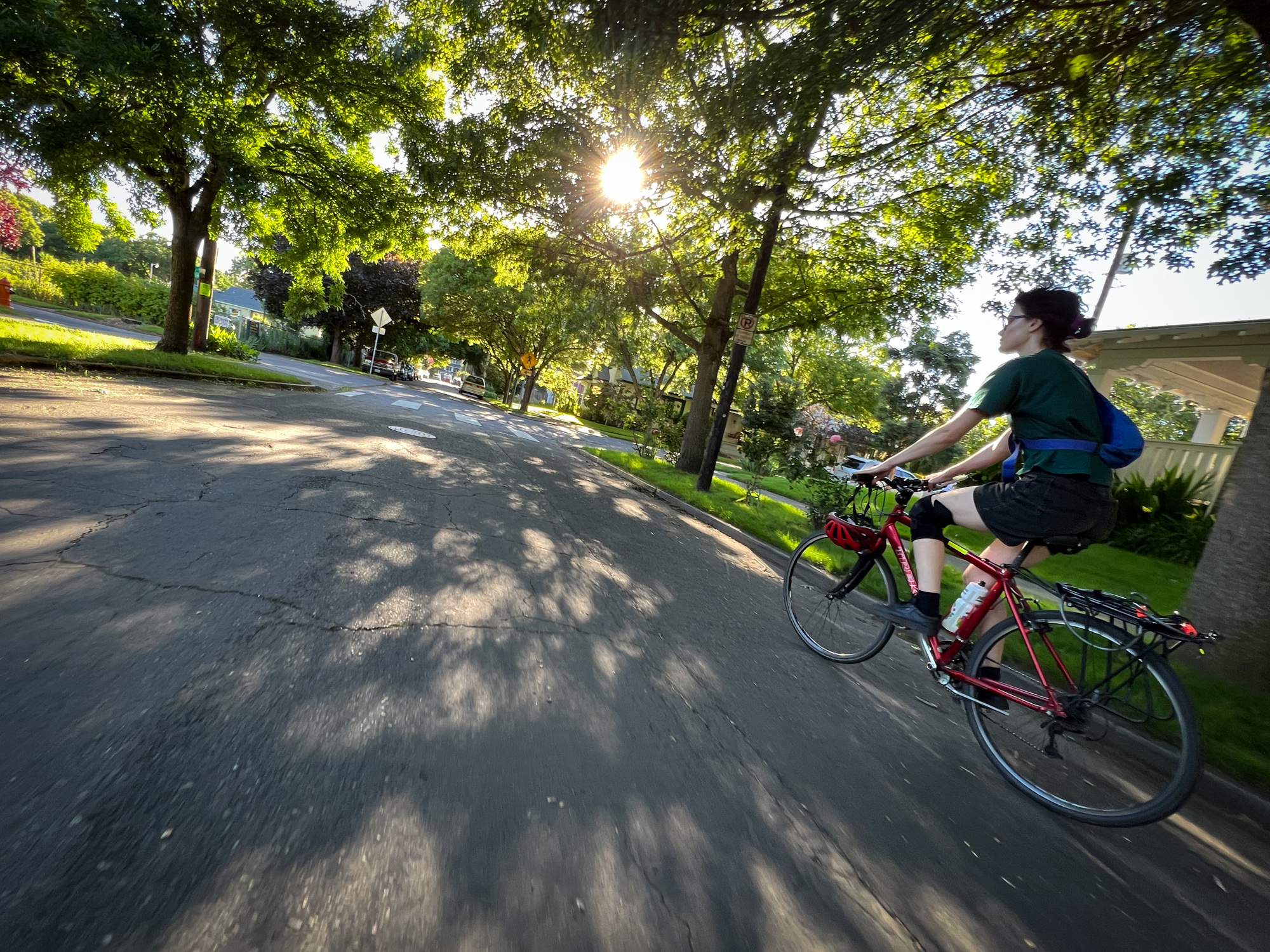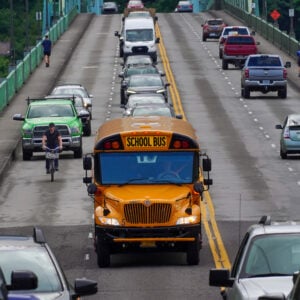Congratulations.
If you’re reading this you made it through our first serious heat wave of the season.
Heat is a serious issue and is becoming an even bigger deal as the planet warms up due to climate change. How serious? 72 people died in Multnomah County during the “heat dome” that happened one year ago this week.
There are lots of things we need to do to create more heat-resilient cities. One of them is very simple and cheap: Maintain and expand our tree canopy and access to shade. Planting trees sounds obvious and trite, but we should not underestimate the power of this simple act.
For those of us who use vehicles — like bicycles — that require human energy to propel and don’t have air conditioning systems, shade takes on even greater importance. It’s one thing to create shady destinations like parks and plazas; but for bicycle riders, a shaded journey is essential too. After all, streets are Portland’s largest public space.
That’s why we are so grateful for Portland’s street tree canopy and for our neighborhood greenways — a citywide network of bike-friendly streets that were designated as such in part due to having more trees and shade than larger arterials.
We’re also grateful for a nascent local movement that’s helping folks connect the dots between heat, trees, and mobility.
Heat Week is a new effort to commemorate those lives lost in 2021 and to raise awareness of the issue. It kicked off Sunday and continues with a bike ride tonight (6/28) as part of Pedalpalooza. The ride is organized by 350PDX and meets at Lents Park (SE 92nd and Holgate) at 5:00 pm. If you can’t make the ride, you can join the picnic starting at 7:00 pm at Colonel Summers Park (SE Clinton and 21st). Along the route you’ll hear from tree experts and experience the impacts of tree canopies firsthand.
So next time you’re riding under stifling sunshine and find yourself steering toward shade, remember it doesn’t just happen. It’s the result of advocacy and smart planning. Cool huh?
Check out our latest TikTok below to learn more and experience some of Portland’s natural air-conditioning:








Thanks for reading.
BikePortland has served this community with independent community journalism since 2005. We rely on subscriptions from readers like you to survive. Your financial support is vital in keeping this valuable resource alive and well.
Please subscribe today to strengthen and expand our work.
Jonathan, heads up that as a mobile reader, the Instagram link gets pushed out to the right of the screen.
Thanks Zach. Fixed it.
This article is one of many from BikePortland, which presents information that is of value, but which I tend not to know, or seldom think about. Thank you.
I never understand why people move here ‘for the trees’ and then cut them down….
In my commute downtown from SW Portland, I often rode on SW Terwilliger – on hot days, there was no more telling route to point out the impacts trees can have than that one. Each and every treed draw was a cool respite from the heat with a constant thermal breeze as the cool air moved downhill.
I was always thinking how caged folks with their windows closed and AC blasting never recognized the benefits of that route.
I’m sure you mean “people driving cages”. /s
Ironic (or maybe just sad) that the city has terminated its tree planting contract with Friends of Trees and modified its zoning code to reduce the number of tree we have.
Tree canopy is a policy, and we’ve deprioritized it.
Colonel Summers Park is between SE 17th and SE 20th and between SE Belmont and SE Taylor. Unless you mean Picollo Park, which is at SE 27th and SE 28th between SE Division and SE Clinton.
Worth reading this report raising concern about shrinking canopy:
https://www.wweek.com/news/2022/03/17/portlands-tree-canopy-has-shrunk-over-the-past-five-years-hitting-residential-areas-hardest/
My observations are that new development routinely allows other competing uses (utility poles, underground utility vaults, on-street parking, etc) to supersede the “required” number of street trees planted, resulting in few or even no trees along many frontages that are now being redeveloped. And, current tree code limits the places trees must be considered for planting, and the size of allowable trees. 25′ canopies are now the max for most species allowed in 3′ planting strips. Replacing a huge old tree with a miniature species results in net loss. I would like to see the tree code amended to require at least *consideration* of curb zones and medians for street tree plantings, for existing and new development. While future bike lanes, or underground utilities make this impossible some places, there are many other places where large-form trees could be planted in large wells, including East Portland streets that have no curbs. Trees require care and tidying up, so they’re not convenient anywhere, but they are necessary everywhere.
Couldn’t agree with you more strongly about the need for shade trees, yet the voices you promote here on BP that advocate for denser development (like that Sightlines guy) are driving the policies that are destroying our urban tree canopy.
Trees need space to grow, yet the infill policies being pushed by BP and others mean large trees are cut down and replaced by shrubby little street trees that will never provide much shade.
You can have dense development or you can have shade trees, but you can’t have both.
It is not a one or the other choice. Like Watts said above, its a policy issue. Sure, peoples yards will get smaller or go away but doesn’t mean the streetscape has to be bare of any trees. It is just more effort to grow large trees in a built environment that (particularly US cities) does not prioritize. It just sucks that most of the native trees to Portland are huge.
You CAN definitely have dense development and shade trees. It’s done all over the world. Downtown, replacing parking lots, low buildings, or any commercial building with a residential one adds density without cutting down any trees at all. A one story house can be replaced with a two or three story structure with multiple units, in the same footprint, so space for trees remains. You could take out thousands of on-street parking spaces and put a large tree in each space. You could reduce a parking lot’s capacity by 10% and plant enough trees to cover most of it with tree canopy. There are tens of thousands of acres of land available for housing here on top of existing low buildings.
I agree that some development policies here conflict with trees. The infatuation with detached ADUs tied with restrictions on sizes of main structures means people are encouraged to add density by filling in their backyards rather expanding upward within the main building’s footprint, as one example. Some greater awareness about (and higher prioritization of) trees whenever density is discussed is certainly needed.
And of course BP articles and comments tend to skew heavily towards views of transportation (less driving, parking, parking lots, etc.) that benefit trees in the city.
I’m about a week late to this party but this is just flat-out wrong. One of our densest neighborhoods also has great street canopy: Northwest Portland aka Nob Hill. The difference is that most of the trees in Northwest (like most of the buildings) predate codes that would limit their size, and because buildings fill the space inside the sidewalks there are fewer yard trees.
We lost several huge old trees on our street in the last few years to storms, but we can‘t replace them with anything that will grow over 25′ tall or wide, as Scott Kocher (above) describes. It has nothing to do with the densification of the neighborhood.
I urge everyone who bikes the MUPs to be on the lookout and report the invasive vine Clematis Vitalba that is smothering our trees to death and spreading its seeds.
I started noticing the vines in the fall/winter when they are covered with dandelion-fuzz-like seedheads blowing all over. This time of year they are leafed out and growing very rapidly, blanketing trees. (You can see examples in some spots along the Springwater Corridor between SE Ivon and Ochoco.)
Please report to Urban Forestry and Bureau of Environmental Services. Follow-up with them and insist that they mitigate the locations you report, and that they add smothering vines to the tree code.
If a property owner or government entity allowed or caused a tree to die by injuring its root, bark, trunk, branches or foliage, or by poisoning, insect infestation, disease, girdling, failing to maintain (water, etc.), topping or excessive pruning, or cutting down without a permit, it would be in violation of Portland tree code. https://www.portland.gov/code/11/70#toc–11-70-050-prohibited-actions- https://www.portland.gov/code/11/80/020
Yet trees are allowed (or caused) to die by these devastating vines, and Urban Forestry won’t do anything until after the tree is dead and poses a risk by falling.
https://www.portlandoregon.gov/parks/47247
https://www.portland.gov/bes/invasive-plants/report-invasive-plant
Steve Lower at 503-823-1640 (Parks and Rec/Urban Forestry)
mitch.bixby@portlandoregon.gov 503-823-2989 (Bureau of Environmental Services)
Old Man’s Beard (Clematis vitalba)
A cousin to our garden clematis varieties, but this one is not well behaved. An invasive climber, this plant can grow 30 feet in a season, and is able to smother large trees. Its fluffy seeds spread far and wide.
I am really disappointed that the massive new dividers running down the middle of Division east of 82nd are filled in with concrete. What a terrible missed opportunity to implement bioswales and plant trees and other vegetation. The large dividers running down MLK have trees that shade cars. Trees and bioswales on Division would have also been an extra deterrent against people just bombing over the dividers, which is a common practice. I’ve read about East Portland having a rapid decline in trees and green spaces and you’d think PBOT would have seized this opportunity but I can also see the massive middle finger pointing at us from the other side of 82nd, so I get it.